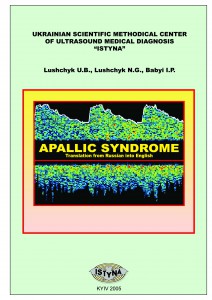Books
APALLIC SYNDROME
Lushchyk U.B., Lushchyk N.G., Babii I.P.
The monograph presents one of the fewest attempts to generalize the latest knowledge about apallic syndrome and persistent vegetative states. Unsuccessful resuscitation, new views’ representation of these states and the newest approaches to treatment are the most urgent problems of nowadays. Our eight-year experience of examining 43 patients in coma and with apallic syndrome, our successful arousing some of them from that condition, bringing them to the level of self-service and to social rehabilitation show that the brain does not die but it is in the state of persistent diashism. Someone may not believe in the possibility of not only long and permanent but also partial renewing effect in such cases; but we are talking about real people and their fates that changed for the better because of the optimism and diligence of doctors and patients and their relatives themselves.
The authors are the doctors–neuropathologists who are proficient in methods of functional and radial diagnostics and they analyse the famous issues about this problem redoing them creatively according to their own experience of successful arousing patients from apallic syndrome.
The edition is intended for doctors-resuscitators, neurologists, neurosurgeons, pediatricians, psychiatrists, and doctors of radial and functional diagnostics, students, internees and post-graduate students of medical institutions.
Brief contents
Theme topicality
Terminology
Comatose states
Pathological approaches to realising brain dysfunction
In comatose states
Apoptosis
Brain death diagnosis: historical overview
Bioethics aspects of the brain death diagnostics

THE UP-TO-DATE POTENTIAL OF AN INTEGRATED FUNCTIONAL ESTIMATION OF THE ARTERIOVENOUS BALANCE IN THE CLOSED VASCULAR SYSTEM ON THE MACRO- AND MICROLEVEL
Popular functional angiology: from main arteries through capillaries to main veins
Lushchyk U.B., Novytskyy V.V., Lushchyk N.G.,
Babii I.P., Alexseyeva T.S.
The book is a brief review of two actual problems in modern diagnostics in the angiology such as
- 1 – diagnostics and estimation of the vascular system’s condition on the regional cerebral level,
- 2 – up-to-date potential of the in vivo non-invasive estimation of structure and function of capillaries on the microcirculatory level.
Basics of modern investigating methods of the vascular system in the organism and interpretation of investigation’s results are performed in the comprehensible form. Possibilities of an integrated application of the ultrasound diagnostics of brain vessels, smart capillaroscopy together with magneto-resonance and radiopague angiography are described.
The state of capillaries’ system as the more important link of the blood-carrying canal, which supply with all substances (required for vital activity) for organs and tissues, gives a lot of interesting extra information in diagnostics. Today the capillaroscopy, which enables to visualize disorders in microcirculation, has become one of progressive methods of diagnostics owing to application of modern electronic-computer technologies and a range of possibilities of its application is quite wide.
The book contains a lot of schemes and colored illustrations
The book is made for medical students, post-graduate students, doctors of general practice, neuropathologists, neurosurgeons, psychiatrists, angiologists and angiosurgeons, resuscitators, doctors of the functional and radial diagnosis, doctors of the intensive therapy departments, family physicians.
Brief contents
1. Macroangiology
Color-coding of gray-scale scanned MRA- and USD-images. Ultrasound diagnostics of brain vessels. Elastic-tonic properties of a vascular wall. Investigation of a pumping function of the myocardium. Modern diagnostic methods of investigation of the vascular system in an aspect of creation of mathematical models. Theoretical models for hemodynamic processes. Conflict of calibers of the main and capillary vessels. Venous dyshemia. Arteriovenous cerebral disbalance. Arteriovenous cerebral pathological shunting. A phenomenon of reactive hyperemia after occlusion of the carotid artery. Application of modern methods of the vascular diagnostics under conditions of neuroresuscitation department (monitoring and correction of regional hemodynamics under critical states). Results of an integrated examination of patients in coma.
2. Microangiology
History of study of microcirculation: from pathomorphological investigations to intravital diagnostics. Theoretical basics of microcirculation regarding the pathomorphological investigations of capillaries. Microcirculation and statistics. Theoretical basics of functioning of the microcirculatory bed regarding problems of hemodynamics. Computed capillaroscopy: the new is a well-forgot old plus up-to-date potential of computed technologies.
Method of examination of the capillary bed. History of issue of classification of disorders in microcirculation. Optic and computed capillaroscopy. Fields of application of the capillaroscopy. Possibility of application of the computed capillaroscopy in the clinical practice. Control of efficiency of treatment with the help of method of the computed capillaroscopy and a method of the clinical interpretation of obtained static and dynamic images.
Innovative vectors of neurorehabilitation
Logic and Management of Multidisciplinary Approach in Restorative Medicine
U.B. Lushchyk, T.M.Titenko, V.V.Novytskyy, V.O.Stukalin, N.H.Lushchyk, V.V.Leonova, A.M.Pryz
This book is devoted to revealing the importance of innovative effective approaches in restorative medicine which are approved by practice. It summarizes more than 15-year experience of physical and medical rehabilitation of psychoneurological patients of different age and severity degree. The book is based on unique developments of private medical establishments ‘Istyna’, ‘Mitera’, and restorative medicine and rehabilitation center of the clinical hospital “Feofania” of the Ukrainian State Administration.
Information gathered in this book can be useful for managers from the fields of public health organization and maintenance, specialists of restorative medicine and other professionals who deal with these areas.
Contents
Introduction
1. Terms and definitions in restorative medicine and rehabilitation
1.1. Relevance of neurorehabilitation for today
1.2. Neurorehabilitation
1.3. Types of rehabilitation and restorative medicine
1.4. Psychological and logopedic methods of neurorehabilitation.
1.5. Instrumental methods of diagnostics and monitoring in rehabilitation
2. Concept of restorative treatment: model, program, process, implementation
2.1. Model of restorative treatment
2.2. Program of restorative treatment as determination of rehabilitation
team’s tactics
2.3. Ways of implementation of restorative treatment programs in
rehabilitation treatment
2.4. Physiotherapy
2.5. Organization of the rehabilitation process as the beginning of
implementation of the restorative treatment program
3. Ground rules of balance, synergy and harmonization in the organism’s
functioning
3.1. Characteristics of a living system
3.2. Homeostasis in living systems
3.3. Autoregulation and feedback approach in the living systems’ functioning
3.4. Fluctuations and mechanical balance
3.5. Chronobiology
3.6. Theory of (self-?)organized criticality
3.7. Role of resonance phenomenon in living systems
3.8. Immunity
3.9. Synergetics
4. Mathematical models of restoration and harmonization of functions
in medicine
4.1. Mathematics and logic of the living organism’s functioning
4.2. Model of the living system’s functioning
4.3. Model of blood circulation investigation
4.4. Some qualitative models of blood and vessel wall motion
4.5. Models of brain’s functioning
4.6. Algorithm of the living system’s convulsive reaction in multidisciplinary
approach
5. Neurorehabilitation for some incurable conditions
5.1. Scientific approaches to neurorehabilitation of seriously ill patients
and its algorithms
5.2. The essence of restorative treatment for autistic children
5.3. Alzheimer’s disease
5.4. Apallic syndrome – chance for healing or total hopelessness?
6. Role of environment in restorative treatment of seriously ill patients
6.1. Restorative care and outside help to a patient
6.2. Family and relatives’ actions during in-house rehabilitation
7. Role of color therapy in rehabilitation process
7.1. Color therapy
7.2. Mathematical fundamentals of color therapy
7.3. Color and light therapy
7.4. Color and its application
7.5. Physiology of color perception
7.6. Main and additional colors, characteristics of color
7.7. Color’s effect on a human organism
8. Harmonizing effect of the system “ Synergis”
8.1. Basic rules of work of the system “Synergis”
8.2. History and principle of use of biological feedback method in the system “Synergis”
8.3. Main indications and fields of application of the system “Synergis”
9. Place of the individually oriented rehabilitation in the comprehensive treatment of psychoneurological patients
9.1. Algorithm for the individually oriented management of the comprehensive diagnostics and restorative treatment
9.2. Role of the multidisciplinary team and rehabilitation approaches in treatment management of neurological and neurosurgical patients in a neurological intensive care unit
9.3. Some aspects of the multidisciplinary approach in modern rehabilitation of seriously ill
patients
10. Kinesitherapy in rehabilitation processes of the motional sphere
10.1. Etiopathogenesis of diseases of the musculoskeletal system and approaches to
treatment
10.2. Treatment management of pathologies of the musculoskeletal system
10.3. Role of mechanotherapy, kinesitherapy, and massage in restorative
medicine
10.4. Place of kinesitherapy in the rehabilitation program for autistic children
10.5. Modern treatment possibilities of kinesitherapy for Alzheimer’s disease patients
11. Psychological approaches in the integrated neurorehabilitation
11.1. Place of a psychologist in supervision of psychoneurological patients
11.2. Application of evidence based medicine’s technologies by psychologists
11.3. Medicated and psychological support during patients’ supervision
11.4. Some negative tendencies in psychologists’ work
12. Logopedic approaches in neurorehabilitation
12.1. Place and role of a logopedist in the rehabilitation team
12.2. Logopedic management for psychoneurological patients
13. Place of musicotherapy in the integrated program of the restorative treatment
13.1. Musicotherapy in formation of a child’s personality
13.2. Peculiarities of the sounds’ physiological effect on a human
13.3. History of musicotherapy development
13.4. Theoretical grounding for the therapeutic effect of musicotherapy
13.5. Forms of musical therapy
13.6. Recipes of the musicotherapeutic effect
14. Situation on neurorehabilitation service on macrolevel
14.1. Prospects of implementation of restorative treatment program in Ukraine
14.2. Strategy of rehabilitation development on the governmental level
14.3. Economic aspects of the intensive integrated neurorehabilitation
List of recommended materials

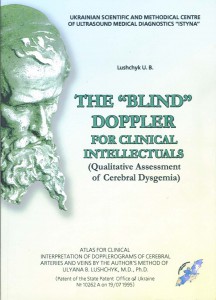 THE “BLIND” DOPPLER
THE “BLIND” DOPPLER
FOR CLINICAL INTELLECTUALS
Qualitative Assessment of Cerebral Dyshemia
ATLAS OF THE CLINICAL INTERPRETATION OF DOPPLEROGRAMS OF THE CEREBRAL ARTERIES AND VEINS BY THE AUTHOR’S METHOD OF ULYANA B. LUSHCHYK, M.D., Ph.D.
Lushchyk U. B.
The educational manual developed according to the educational program of the scientific center “Istyna”, maintained by the Department of Health of Ukraine.
The present manual is a book, atlas & teach-yourself book of the unique methods of the clinical interpretation of ultrasound dopplerograms for the qualitative assessment arterial-venous – liquor balance disturbances in the functioning of the vascular cerebral system.
The educational manual provides fundamentals for USD of the cerebral-vascular pathology owing to methods of the USD dopplerography.
We have considered a new methodical approach to clinical ultrasound diagnosis cerebrovascular diseases including anatomic-physiological peculiarities of blood supply for arterial and venous cerebral beds, fundamentals for the topography of vascularization of the brain. The present manual presents main approaches to realizing of the physics of ultrasound phenomena and principles of the up-to-date ultrasound system’s functioning and also describes the clinical and dopplerographic picture that shows functioning of the collateral circulation tract, steal – syndromes. The illustrative material is proposed for more convenient assimilation of the theoretical knowledge and practical skills of the methods adoption.
The present manual is complied for medical students, post-graduate students, family physicians, neurosurgeons, psychiatrists, angiologists, angiosurgeons, and doctors of the functional and radial diagnosis, doctors of the intensive therapy departments.
Brief contents
1 Ultrasound diagnosis of vessels (USDV). Historical overview.
2 Information received from the ultrasound dopplerography compared with other methods of diagnosing with the objectivating of neurovascular pathology.
3. The applied anatomy and physiology of main cerebral arteries and veins.
4. Physical fundamentals for the ultrasound diagnosis.
5. Ultrasound diagnosis of brachiocephalic and cerebral vessels.
6. Quantitative and qualitative assessment of dopplerograms.
7 Criteria of the clinical interpretation of cerebral dopplerograms.
8. Intracranial hydrodynamic disturbances.
9. Analysis of functions of the collateral tracts of the arterial and venous cerebral blood supply.
10. Functional tests for checking of the vascular reactivity.
11. Applied capacities of the ultrasound clinical diagnostics of the vascular pathology in the psychoneurological practice.
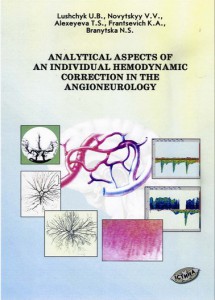 ANALYTICAL ASPECTS OF AN INDIVIDUAL HEMODYNAMIC CORRECTION IN THE ANGIONEUROLOGY
ANALYTICAL ASPECTS OF AN INDIVIDUAL HEMODYNAMIC CORRECTION IN THE ANGIONEUROLOGY
individual selection of efficient vasoactive remedies under control of non-invasive methods for investigation of the vascular system in the brain such as: magneto-resonance tomography, transcranial coloured angioscanning, ultrasound dopplerography
Lushchyk U.B., Novytskyy V.V.,Alexeyeva T.S., Francevich K.A., Branytska N.S
The development of the up-to-date diagnostic equipment for the computed and magneto – resonance tomography, ultrasound vascular diagnostics, electroencephalography etc. gives the possibility to find and observe structural and functional changes in vessels and tissues of the brain in dynamics. Development of the optimum alternative for the integrated diagnosing of the vascular bed condition and dynamic observation of serious patients has to assist to decreasing of the number of cerebrovascular diseases. An individual application of vasoactive medicines takes on the special significance. It is directed only on provoked links of the cerebral and system hemodynamics and it excludes the formation of the unjustified cerebral hyperemia.
The development of the up-to-date diagnostic equipment for the computed and magneto – resonance tomography, ultrasound vascular diagnostics, electroencephalography etc. gives the possibility to find and observe structural and functional changes in vessels and tissues of the brain in dynamics. Development of the optimum alternative for the integrated diagnosing of the vascular bed condition and dynamic observation of serious patients has to assist to decreasing of the number of cerebrovascular diseases. An individual application of vasoactive medicines takes on the special significance. It is directed only on provoked links of the cerebral and system hemodynamics and it excludes the formation of the unjustified cerebral hyperemia.
Brief contents
1. Angioneurology: achievements and problems.
2. Hemodynamic system of blood supply for the brain.
3. Peculiarities of the early ontogenesis of the brain and its vascular link.
4. Age peculiarities of the cerebral hemodynamics in the norm and with vascular – cerebral pathology.
5. Applied aspects of usage of angioarchitectonic types in assessment of the vascular brain pathology in patients with discirculatory encephalopathy.
6. Methods of mathematical modeling for vascular dyshemias.
7. Pathogenetic approach to selection of vasoactive remedies for patients with cerebrovascular pathology.
8. Theoretical basis and applied algorithms of usage of vasoactive medical remedies’ combination.

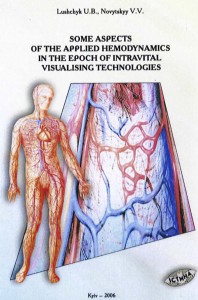 SOME ASPECTS OF THE APPLIED HEMODYNAMIC IN THE EPOCH OF THE INTRAVITAL VISUALISING TECHNOLOGIES
SOME ASPECTS OF THE APPLIED HEMODYNAMIC IN THE EPOCH OF THE INTRAVITAL VISUALISING TECHNOLOGIES
clinical interpretation and prognostication of hemodynamic reconstructions under control of the modern investigating methods of the vascular system of the organism
Lushchyk U.B., Novytskyy V.V.
This book is a short review of the present condition of such actual problem in the modern angiologia like assessment of functioning of the vascular system on the regional cerebral and microcirculatory level. Some aspects of the hemodynamics are stated in the accessible form, which knowledge might help in mastering of the modern investigating methods of the vascular system in the organism and at the interpretation of results from the investigation. The book describes specific features of the modern diagnostic equipment and possibility of its integrated application as diagnostics of vascular diseases.
It is intended for medical students, angiosurgeons, neurosurgeons, angiologists, resuscitators, rehabilitologists, physiologists and biophysicians.
Brief contents
1. Diagnosing methods of the vascular system (history of development of methods for investigation the vascular system in the organism in-vivo and in-vitro.
2. Basic regulations of the hydromechanics as the basics for investigation of blood flow.
3. Hemodynamics is a science about blood circulation.
4. Hemodynamics according to the rheological blood peculiarities.
5. Basic principles of structure and functioning of the vascular system in the human organism.
6. Elastic- tonic characteristics of the vascular wall.
7.Conflict of calibers of the cerebral and major vessels.
8. Arteriovenous cerebral misbalance

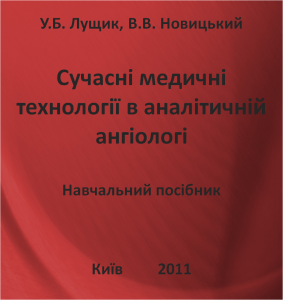 Modern medical technologies in analytical angiology
Modern medical technologies in analytical angiology
Lushchyk U.B., Novytskyy V.V.
The manual is an attempt to make a structured analysis of stages of development of medical instrument-making on the example of transformation and perfection of processes of research of one of the major systems of human organism – cardiovascular.
Contents
1. Research of the cardiovascular system: fundamental and applied aspects in solving of the current problems with cardiovascular diseases
1.1. CARDIOVASCULAR DISEASES ARE INVASION OF ХХІ CENTURY
1.2. BRIEF REVIEW OF PROBLEMS WITH RESEARCH OF CARDIOVASCULAR SYSTEM
1.3. Current tendencies of development and features of ultrasound diagnostic technologies
1.4. Modern information technologies in medicine
1.5. Modern medical technologies and evidential medicine
1.6. BASIC DIAGNOSTIC CRITERIA IN EVIDENTIAL MEDICINE
1.7. ECONOMIC VALUE FOR PRACTICAL health protection with application of modern medical technologies
2. Features of structure and functioning of the cardiovascular system on the example of model of vascular “Hemoduct”
2.1. Brief description of the human cardiovascular system
2.2. Features of structure of the cardiovascular system by analogy with water supply system
2.3. Feature of the cardiovascular system as a model of plumbing in a living organism
2.3.1. Model of the cardiovascular system as analogue of the water supply and blood supply system 2.3.2. Features of structure and functioning of the cardiovascular system in the “hemoduct” model in the living organism
3. Devices and non-destructive control of the vascular system in medical diagnostics and medical practice
3.1. Historical overwiew of development of research methods of the human vascular system in vivo and in vitro
3.2. Methods and medical devices for the vascular system exanimation
3.2.1. Rheography
3.2.2. Sphygmography
3.2.3. Echoencephalography (EchEG)
3.2.4. Optic and smart capillaroscopy
3.2.5. Radionuclide diagnostics (scyntigraphy)
3.2.6. Radiocontrast angiography
3.2.7. Ultrasound diagnostics of vessel pathology
3.2.8. Laser Doppler flowmetry (LDF)
3.2.9. Computer tomography
3.2.10. Magnetic-resonance tomography in angiomode (MRA)
3.2.11. Perfusion МRT
3.2.12. Color-coding of gray-scaled scanned MRA and US images
3.3. COMPARATIVE DESCRIPTION OF SOME INFORMING RESEARCH METHODS OF THE HUMAN VASCULAR SYSTEM
4. SOME ASPECTS AND PROSPECTS OF DEVELOPMENT OF MEDICAL INSTRUMENT-MAKING OF MEDICAL TECHNOLOGIES
4.1. Current development of medical instrument-making status in Ukraine
4.2. The present state of businesses in a medical instrument-making: Russian experience
4.3. Conception of medical instrument-making
4.3.1. Pre-conditions of creation of new conception for medical instrument-making
4.3.2. Bases of new conception and system-technical standard of medical instrument-making
4.3.3. Conceptual role of screening technologies in relation to the factors of development of CVD on the Russian example
5. Modern innovative technologies in the analytical approach to screening of the cardiovascular system on a microlevel: smart optical capillaroscope
5.1. A role of capillaries in the human organism
5.2. Optic capillaroscopy. History of the method development
5.3. Smart capillaroscope
5.4. Capillary exanimation method
5.5 History of forming of methods of clinical interpretation of changes in microcirculation
5.6. Capillaroscopy application
5.7. Control of treatment efficiency by capillaroscopy
5.8. Advantages of capillaroscopy





